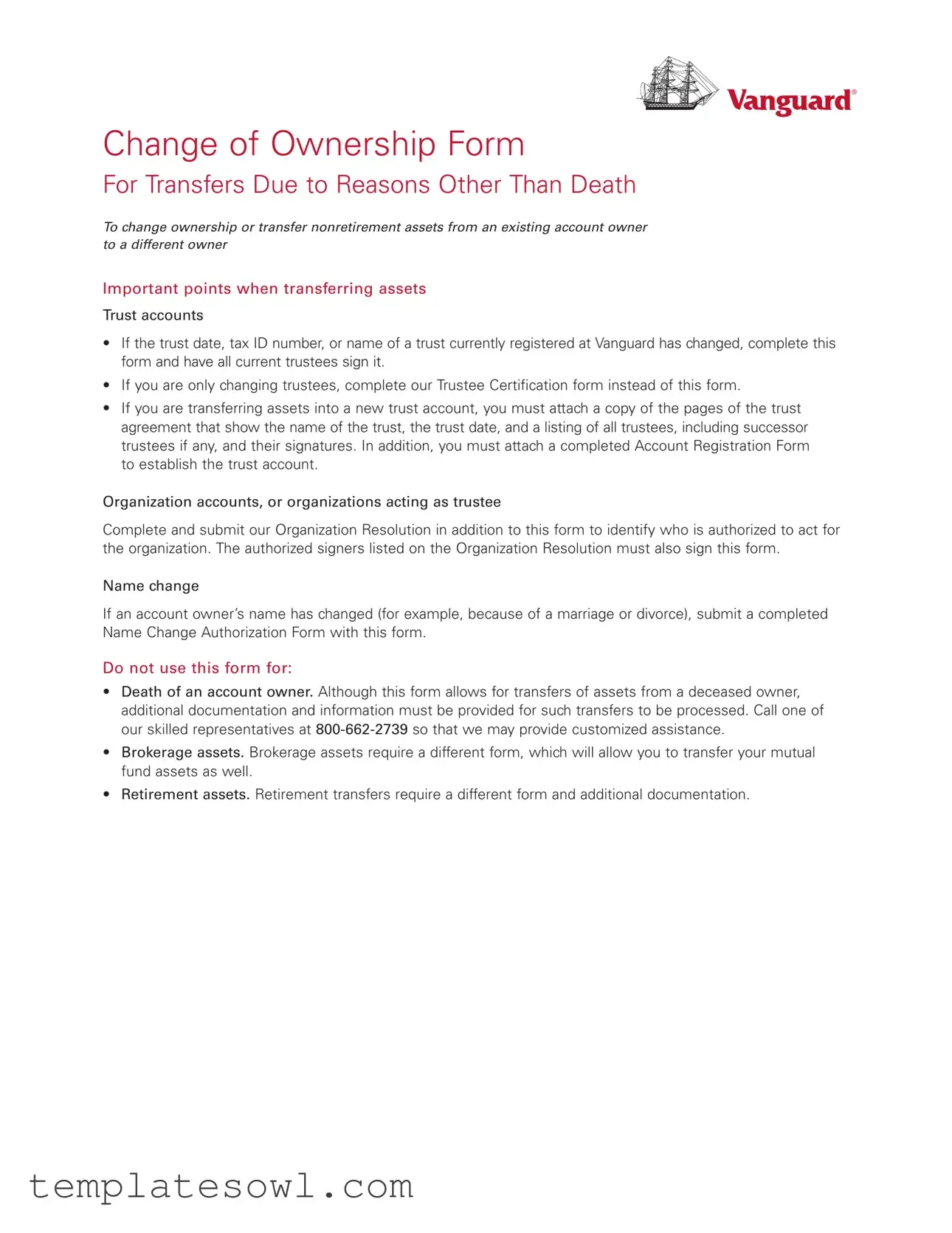Change of Ownership Form
For Transfers Due to Reasons Other Than Death
To change ownership or transfer nonretirement assets from an existing account owner to a different owner
Important points when transferring assets
Trust accounts
•If the trust date, tax ID number, or name of a trust currently registered at Vanguard has changed, complete this form and have all current trustees sign it.
•If you are only changing trustees, complete our Trustee Certification form instead of this form.
•If you are transferring assets into a new trust account, you must attach a copy of the pages of the trust agreement that show the name of the trust, the trust date, and a listing of all trustees, including successor trustees if any, and their signatures. In addition, you must attach a completed Account Registration Form to establish the trust account.
Organization accounts, or organizations acting as trustee
Complete and submit our Organization Resolution in addition to this form to identify who is authorized to act for the organization. The authorized signers listed on the Organization Resolution must also sign this form.
Name change
If an account owner’s name has changed (for example, because of a marriage or divorce), submit a completed Name Change Authorization Form with this form.
Do not use this form for:
•Death of an account owner. Although this form allows for transfers of assets from a deceased owner, additional documentation and information must be provided for such transfers to be processed. Call one of our skilled representatives at 800-662-2739 so that we may provide customized assistance.
•Brokerage assets. Brokerage assets require a different form, which will allow you to transfer your mutual fund assets as well.
•Retirement assets. Retirement transfers require a different form and additional documentation.
Mailing information
Make a copy of your completed form for your records.
If you do not have
apostage-paid envelope, mail to:
For overnight delivery, mail to:
Mail your completed form and any attached information in the enclosed postage-paid envelope.
Vanguard
P.O. Box 1110
Valley Forge, PA 19482-1110
Vanguard
455 Devon Park Drive
Wayne, PA 19087-1815
Reminders
•If the transferred assets are going to a new account, submit a completed Account Registration Form with this form. Important: Account options, such as automated and electronic bank transfers, will not carry over from the original account to the receiving account. You will need to reestablish any account options on the Account Registration Form.
•If the account owner’s name has changed, submit a completed Name Change Authorization Form.
Form FTFR
Change of Ownership Form
Use this form to change ownership or transfer nonretirement assets to a different account owner. Brokerage and retirement accounts require a different form.
Please print in capital letters and use black ink.
Questions?
Call 800-662-2739.
If you need other forms or want to complete this form online, visit our
website at www.vanguard.com/ serviceforms.
1. Current Account Owner Information
Provide the full, legal name. >
Important: If this is a transfer from a deceased client’s account, provide the name of the deceased in the Name of Owner box.
Name of Owner, Minor, or Trustee first, middle initial, last
|
Last Four Digits of Social Security Number or Employer ID Number |
Zip Code |
|
|
|
|
|
|
Account Number |
|
|
|
|
|
|
|
|
|
|
|
|
Name of Joint Owner, Custodian, or Trustee first, middle initial, last
Name of Trust or Organization
2. Assets You Want to Transfer
Check one.
■Transfer ownership of all assets in this account.
If you need more space, provide the
information on a > separate sheet.
■Transfer ownership of the following assets only.
Fund Number |
|
Account Number |
Dollar Amount or |
Number of Shares or |
Percentage |
|
|
|
|
|
|
|
|
|
Fund Number |
|
Account Number |
Dollar Amount or |
Number of Shares or |
Percentage |
|
|
|
|
|
|
|
|
|
|
|
|
|
|
|
|
|
|
Fund Number |
|
Account Number |
Dollar Amount |
or |
Number of Shares |
or |
Percentage |
|
|
|
|
|
|
|
|
|
|
|
|
|
|
|
|
|
|
Fund Number |
|
Account Number |
Dollar Amount |
or |
Number of Shares |
or |
Percentage |
|
|
|
|
|
|
|
|
|
|
|
|
|
|
|
|
|
|
Dollar Amount or Number of Shares or Percentage
Form FTFR
3. Account to Receive the Transfer
Check one.
■Transfer shares to a new Vanguard account. Complete our Account Registration Form and mail it with this form. Please list the name(s) of the new account owner(s).
Name of Owner, Minor, or Trustee first, middle initial, last
Name of Joint Owner, Custodian, or Trustee first, middle initial, last
Name of Trust or Organization
■Transfer shares to an existing Vanguard account.
This number must differ from the
account number(s) > listed in Section 1.
Name of Owner, Minor, or Trustee first, middle initial, last
Account Number
Name of Joint Owner, Custodian, or Trustee first, middle initial, last
Name of Trust or Organization
Form FTFR
4. Signature(s) of Current Owner(s) and/or Representative(s)
By signing below, the current owner(s) and/or his/her/its representative(s) authorizes the transfer of the Vanguard fund shares identified in Section 2 in accordance with the terms of this form and of any additional form that Vanguard requires to effect the transfer.
A signature guarantee is required if the current owners, who are transferring assets, are not owners on the receiving account. If an owner is:
•A minor, the custodian named on the account must sign below, and must obtain a signature guarantee if the receiving account is not in the minor’s name.
•Deceased, the legal representative must sign below, and must obtain a signature guarantee if the shares are not being transferred to the estate.
If a signature guarantee is required and you do not provide one, this change of ownership request will not be processed. If you have any questions, call Vanguard at 800-662-2739.
If a signature guarantee is required,
DO NOT sign until > you are in the presence of the
authorized officer.
|
Account Owner’s Signature |
Date mm/dd/yyyy |
|
|
|
|
|
|
|
|
|
|
|
|
|
|
|
Print Name
You can get a signature guarantee from an authorized officer of a bank, broker, and many other financial institutions.
A notary public CANNOT provide a signature guarantee.
Signature of Authorized Officer of Guarantor
Authorized Officer’s Title
Name of Institution
Date mm/dd/yyyy
If additional signatures are required, photocopy this page and attach it to this form.
|
Account Owner’s Signature |
Date mm/dd/yyyy |
|
|
|
|
|
|
|
|
|
|
|
|
|
|
|
|
|
|
Print Name
Signature of Authorized Officer of Guarantor
Authorized Officer’s Title
Name of Institution
Date mm/dd/yyyy
Form FTFR
© 2009
The Vanguard Group, Inc. All rights reserved.
FTFR 0709





